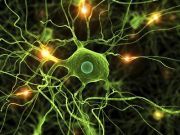Loss of CD62L on T Cells is Associated with Risk of Developing Progressive Multifocal Leukoencephalopathy in Patients Treated with Natalizumab
Researchers suggest that monitoring for the loss of CD62L expression on CD4+ T cells is a biomarker for risk assessment in patients treated with natalizumab who may develop PML, since other treatments do not show this pattern of C62L loss of expression.

Copenhagen, Denmark — October 5, 2013 – Late-breaking study results reported today gave insight into how natalizumab works in patients with multiple sclerosis (MS) and the molecular and cellular changes it induces. The practical implication of these data was the identification of biomarkers to monitor the course of MS and to focus on the development of natalizumab-associated progressive multifocal leukoencephalopathy (PML), a serious health concern that develops in some patients receiving natalizumab for 25 to 48 months. CD49, which is found on adherins that mediate cells crossing the blood-brain barrier, was proposed as a marker to monitor aspects of MS, including relapse and the clinical efficacy of natalizumab. The loss of CD62L expression on T cells can be used to identify patients at risk for the development of natalizumab-associated PML.
Long-term use of natalizumab is a double-edged sword for a proportion of patients with MS; natalizumab is a monoclonal antibody targeting CD49 that interferes with efficient migration of leukocytes across the blood—brain barrier, thus lowering the number of immune cells migrating to sites of inflammation within the central nervous system (CNS). Natalizumab has also been associated with an increased risk for PML, an opportunistic infection caused by JC virus reactivation and migration into the CNS, which can result in disability or death. An inverse relationship between the length of natalizumab treatment and the proportion of CD34 /CD49 cells has previously been observed.
Findings were presented on October 5 during the “Late Breaking News” session of the 29th Congress of the European Committee for Treatment and Research in Multiple Sclerosis (ECTRIMS) and the 18th Annual Conference of Rehabilitation in MS. Heinz Wiendl, MD, from the Department of Neurology, Julius-Maximilians-University Würzburg, Germany, described an immune climate in the central nervous system that is specific to patients with MS and outlined the changes in this climate, both over the course of disease progression and following natalizumab treatment. Flow cytometry was used to separate cell populations in the CNS to track changes in the molecular composition of the CNS in a cross-sectional cohort of 350 patients that received natalizumab for 18 to 80 months; of these patients16 had already developed PML.
In the periphery, CD49d expression was seen to be down regulated and another marker, PSGL-1, was strongly upregulated, possibly as a result of strong and persistent T-cell activation by natalizumab; no major changes in the cellular population were seen in the peripheral T-cell compartments. However, the CSF of natalizumab-treated patients showed an almost exclusive T cell effector-memory signature. “Natalizumab has created an unprecedented and unique condition,” Wiendl said. This signature is comprised of a decreased ratio of T-effector cells and T memory cells — “these are the bad guys associated with MS pathogenesis,” said Wiendl. There was no CD49d expression on the T cells in this compartment, suggesting alternative mechanisms were used for the entry of T cells into the CSF. “The immune system is compensating for the block in the CD49d pathway; this means there must be a nonCD49d mechanism that allows cells to enter this compartment,” said Wiendl. MS patients treated with other drugs showed a different pattern.
CD49d expression changed with natalizumab treatment; CD49d expression on peripheral T cells was immediately down-regulated upon the beginning of natalizumab treatment but regained that of healthy controls over the course of long-term therapy. CD49d downregulation was not seen in relapsing patients or in patients who were positive for natalizumab-neutralizing antibodies.
The functional relevance of upregulation was that shear-flow experiments with glass capillaries coated with P-Selectin (PSGL-1 ligand) plus cultured primary human brain-derived microvascular endothelial cells showed a high degree of capture of patient-derived CD4+ T cells that expressed L-selectin (CD62L), which strongly associated with PML development. This association was based on samples from eight patients who gave blood before the diagnosis of PML; the percentage of CD62L expressing CD4+ T cells was significantly lower in all of these patients (4.6%) when compared with non-PML natalizumab-treated patients (40.2%; P≤0.0001).
From these data it was postulated that natalizumab treatment over time induces a change in the central T-cell effector/memory compartments and induces strong peripheral T-cell activation that decreases adhesion molecule expression, in particular CD49d and CD62L. The level of CD49d expression on CD4+ T cells may be monitored in patients treated with natalizumab and can help identify patients who are having continued clinical activity including relapse, and are expressing antibodies to natalizumab and therefore, not responding to treatment. Monitoring for the loss of CD62L expression on CD4+ T cells is a biomarker for risk assessment for individual patients receiving natalizumab who may develop PML since other treatments do not show this pattern of C62L loss of expression. Interestingly, patients who recovered from PML showed a regeneration of CD62L expression.
Wiendl indicated that this monitoring was already in place in his practice. Decisions regarding the continued use of natalizumab are made based upon the level of CD62L. “Depending on the risk category of patients low in CD62L, it may mean treatment cessation or assessment every 6 months. This is how we currently do that at our center. We are trying to cross-validate this assay to integrate it into daily practice,” he explained.
This research was funded by the Deutsche Forschungsgemeinschaft (DFG) or German Research Council.